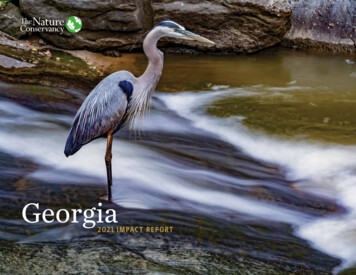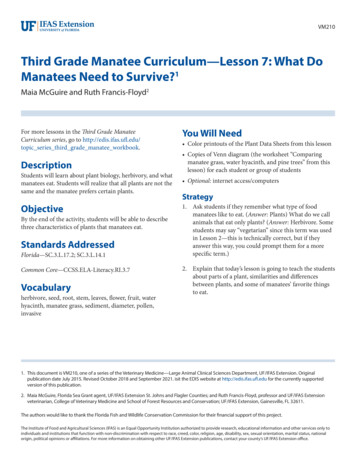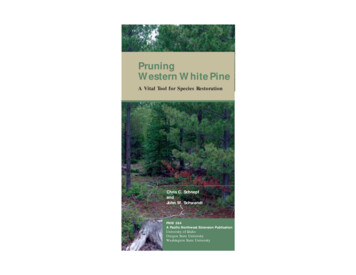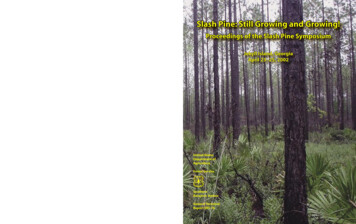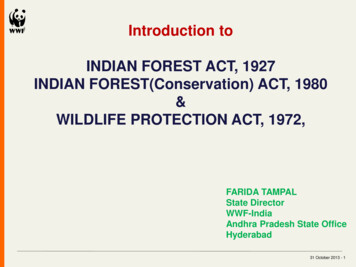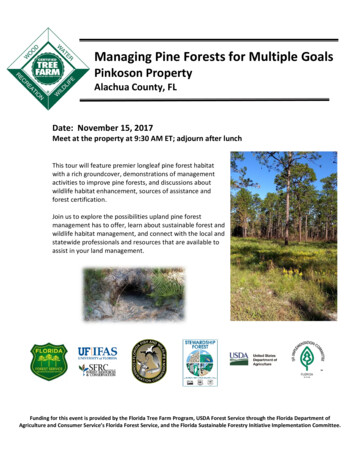
Transcription
Managing Pine Forests for Multiple GoalsPinkoson PropertyAlachua County, FLDate: November 15, 2017Meet at the property at 9:30 AM ET; adjourn after lunchThis tour will feature premier longleaf pine forest habitatwith a rich groundcover, demonstrations of managementactivities to improve pine forests, and discussions aboutwildlife habitat enhancement, sources of assistance andforest certification.Join us to explore the possibilities upland pine forestmanagement has to offer, learn about sustainable forest andwildlife habitat management, and connect with the local andstatewide professionals and resources that are available toassist in your land management.Funding for this event is provided by the Florida Tree Farm Program, USDA Forest Service through the Florida Department ofAgriculture and Consumer Service’s Florida Forest Service, and the Florida Sustainable Forestry Initiative Implementation Committee.
Table of ContentsPageTour InformationTour Resource Contacts4Florida Forest Stewardship Program Fact SheetTree Farm Program Fact SheetSilviculture Best Management PracticesForestry Wildlife Best Management Practices for State Imperiled SpeciesGot Invasives? Get Assistance.56789Longleaf Pine RegenerationTen Tips for Increasing Wildlife Biodiversity in Your Pine PlantationsThinning Southern Pines: A Key to Greater ReturnsUF/IFAS Forest Management and Stewardship PublicationsNote space1017212627AssistancePublicationsWe appreciate the support of our2017 Florida Tree Farm Program Donors-listed on the back cover-
Tour Resource ContactsDave ConserAlachua County ForesterFlorida Forest Service5353 NE 39th AvenueGainesville, FL 32609(352) 395-4927Robin HollandSilvicultural BMP ForesterFlorida Forest ServiceIndian Lake Forestry Station6675 NE 40th Ave RdOcala, FL 34479(352) 732-1273Kevin KorusExtension AgentUF/IFAS Alachua CountyExtension2800 NE 39 AveGainesville, FL 32609(352) 955-2402kkorus@ufl.eduChris DemersExtension Program ManagerFlorida Forest Stewardship ProgramUF/IFAS School of ForestResources & ConservationPO Box 110410Gainesville, FL 32611(352) 846-2375cdemers@ufl.eduMonica JonesDistrict ConservationistUSDA Natural ResourcesConservation Service5709 NW 13th StGainesville, FL 32653(352) 376-7414 ext. 3Monica.Jones@fl.usda.govGreg MarshallRegional Cooperative AssistanceCoordinatorFlorida Forest Service410 SE Oleno Park RdHigh Springs, FL 32643(352) 233-8342Jo EmanuelWildlife BiologistPartners for Fish and WildlifeProgramU.S. Fish and Wildlife Service7915 Baymeadows Way, Suite 200Jacksonville, FL 32256(904) 731-3093Jo Emanuel@fws.govJoe MackenzieGilchrist and Levy County ForesterFlorida Forest Service7240 S US Hwy 129Trenton, FL 32693(352) 463-3138Joe VaughnLandowner Assistance BiologistFlorida Fish and WildlifeConservation Commission5353 NE 39th AvenueGainesville, FL 32609(352) l@freshfromflorida.comFor more about the Florida Tree Farm Program see:https://www.treefarmsystem.org/florida
Florida’s Forest Stewardship ProgramForest Stewardship is active management of forest land tokeep it in a productive and healthy condition for present andfuture generations, and to increase the economic,environmental and social benefits of these lands. ForestStewards are landowners who manage their forest lands on along-term basis by following a multiple resourcemanagement plan.The Forest Stewardship Program addresses theimprovement and maintenance of timber, wildlife, soil andwater, recreation, aesthetics, as well as forage resources.EligibilityPrivate forest landowners with at least 20 acres of forest land and a desire to managetheir ownerships according to Stewardship principles can participate in the ForestStewardship Program. Also, adjacent landowners, with similar managementobjectives, may combine their holdings to meet this acreage limitation.Benefits to Landowners A customized management plan that is based on the landowner's objectives. Theplan will include forest stand characteristics, property maps, managementrecommendations, and a five-year time line for future planning. This plan alsoserves as documentation of active management on the property that may helpreduce tax liability.An opportunity for public recognition as a certified "Forest Steward".Educational workshops, tours and the quarterly Florida Land Steward newsletterdeveloped and distributed by the University of Florida, IFAS CooperativeExtension Service and other partners.How to EnrollContact your local Florida Forest Service County Forester and tell them that you wouldlike to have a Forest Stewardship Plan prepared for your property. More informationand application online at: http://FreshFromFlorida.com/ForestStewardship
Tree Farm ProgramThe American Tree Farm System is a program of theAmerican Forest Foundation and was founded in 1941 topromote the sustainable management of forests througheducation and outreach to family forest landowners. Nearly 26million acres of privately owned forestland and 80,000 familyforest landowners in 46 states are enrolled in this program andcommitted to excellence in forest stewardship. About half ofall Tree Farms are located in the South.EligibilityPrivate forest landowners with at least 10 acres of forest land and have a desire tomanage their ownerships according to sustainable forestry guidelines can participatein Tree Farm.Benefits to LandownersTree Farmers are good stewards of their forestland committed to protectingwatersheds and wildlife habitat and conserving soil. They manage their forestlandfor various reasons, including timber production, wildlife, recreation, aesthetics,and education/outreach. Tree Farmers receive many benefits:- Representation on local, state, and federal issues affecting forestland owners.- Exposure to a network of forestry professionals and landowners committed tosustainable forestry.- Invitations to workshops, tours and the quarterly Florida Land Steward newsletterproduced by University of Florida IFAS and other partners.- Certification that meets international standards of sustainable forest management.- Participation in local, state, regional, and national Outstanding Tree Farmer of theYear awards and recognition.Getting into the ProgramContact your local Florida Forest Service County Forester and tell them that youwould like to join the Tree Farm program. More information here:https://www.treefarmsystem.org/florida
Florida Forest ServiceSilviculture Best Management PracticesSilviculture Best Management Practices (BMPs)Silviculture BMPs are the minimum standards necessary to protect our state’s waterbodies andwetlands from degradation and sedimentation that can sometimes occur because of erosion fromforestry operations. Silviculture BMPs should be applied on all bonafide ongoing forestry operations,especially those adjacent to waterbodies and wetlands, and may be enforced by federal, state and localauthorities.Silviculture BMP Courtesy ChecksSilviculture BMP courtesy checks are available for landowners, land managers, and loggers. Thesecourtesy checks provide a “report card” on Silviculture BMP implementation for recent or ongoingforestry operations. This helps future management planning and evaluates the performance ofcontractors on your property.Silviculture BMP Site AssessmentsOn-the-ground Silviculture BMP site assessments are available to determine which Silviculture BMPsapply to planned operations on a specific site. This helps with harvest plan development, road layout,mitigation of existing problem areas, etc.Silviculture BMP Notice of IntentThe Silviculture BMP Notice of Intent (Rule 5I-6 F.A.C.) is a voluntary, one-time pledge that a landownersigns, indicating intent to adhere to Silviculture BMPs on their property. Once a landowner has signedthe Notice of Intent, he or she will become eligible to receive a presumption of compliance based onreasonable evidence with state water quality standards during future ongoing forestry operations. Thisis very important if a landowner’s property falls within an area covered by a Florida Department ofEnvironmental Protection Basin Management Action Plan for impaired waters.Additional ServicesFor information on the services listed above or any other services provided by the Florida ForestService’s hydrology section, please contact your local BMP Forester.Roy LimaPanhandle AreaRoy.Lima@FreshFromFlorida.com(850) 681-5942Robin HollandPeninsula AreaRobin.Holland@FreshFromFlorida.com(352) 732-1273
ForestryWildlife Best Management Practicesfor State Imperiled Species Forestry Wildlife Best Management Practices for State Imperiled Species (WBMPs) wereadopted into Florida Administrative Code (Rule 5I-8) on October 21, 2014. WBMPs were developed through a partnership between the Florida Department ofAgriculture and Consumer Services’ Florida Forest Service and the Florida Fish andWildlife Conservation Commission (FWC). WBMPs are voluntary practices designed as a practical approach for avoiding andminimizing the loss of State Imperiled Species due to silviculture operations. WBMP practices address the 16 State Imperiled Species which are considered to bepotentially vulnerable to silviculture operations including ten aquatic species, twoburrowing animals, and four nesting birds. WBMPs are designed to supplement the existing water quality-based Silviculture BMPswhich already provide many valuable benefits to the conservation and management offish and wildlife in Florida. Landowners and other forestry resource professionals can enroll in the voluntaryprogram by completing a WBMP Notice of Intent. Those who do not wish to enroll willcontinue to be subject to all current laws and regulations regarding State ImperiledSpecies. Once enrolled, applicants who properly implement WBMPs will no longer be requiredto obtain a permit authorizing the incidental take of State Imperiled Species duringbonafide ongoing forestry operations. In addition, they will not be subject to any fines orpenalties associated with an incidental take of the State Imperiled Species covered by theWBMP Manual. WBMPs are not designed to facilitate wildlife habitat restoration or species recovery andexpansion. Also, they do not address any Federally Listed Species. For information onFederally Listed Species, refer to FWC’s online “Florida Wildlife Conservation Guide.” To obtain more information or a copy of the WBMP Manual and Notice of Intent, contactyour local Florida Forest Service BMP forester (see below) or a FWC LandownerAssistance Program biologist (850) 488-3831.Florida Forest Service BMP ForestersRoy LimaPanhandle Area(850) 681-5942Robin HollandPeninsula Area(352) @FreshFromFlorida.com
Got lnvasives?Invasive exotic plant problem? Find aprogram to help by usingFloridaInvasives.org.The Florida Invasive Species Partnership has collected, evaluated and categorizedassistance programs into a single resource, making it easier to find the financialand/or technical assistance available to Florida landowners to prevent or controlinvasive exotic species problems. Floridalnvasives.org has an online resource ofmanagement assistance programs to help in your fight against problematic plantspecies. This resource takes the guesswork out of finding the agencies or organizationsoffering assistance and will direct you to available programs. The Landowner’sIncentives Database will also provide the requirements for each program, to help youdecide if they are a good match for your needs.Why was Floridalnvasives.org developed?Invasive species have been identified as being costly ecologically and economicallystatewide in Florida. The Florida Invasive Species Partnership (FISP) is a collaborationof public and private entities in Florida, formed to link efforts at preventing andcontrolling invasive exotic plants across agency and property boundaries. FISP hasdeveloped an on-line tool of available financial and technical assistance sources tomake it easier for landowners and land managers to find them.How does Floridalnvasives.org help you?FISP has created a searchable database, the Florida landowner incentives database,accessible at Floridalnvasives.org that allows you to find an assistance program foryour needs. Search by your county, target species or other pertinent information intothe online tool, and you will retrieve a current list of available programs.Floridainvasives.org will help provide focus to your search so that you can get theright person at the right program.Floridalnvasives.org: Builds community awareness, Leverages limited resources through cooperation and May reduce individual land management costs.This resource will be regularly updated with the most current programinformation to provide you the most up-to-date opportunities.Go to Floridalnvasives.org to find out more.Species Shown from top to bottom:Mexican Petunia, Boston Fern, Mimosa, Cogongrass, Camphor[Type here]
SS-FOR-13Longleaf Pine Regeneration1Chris Demers, Alan Long, and Patrick Minogue2Longleaf pine (Pinus palustris) has many favorable characteristics for landowners who have long-term, multiple-useresource management objectives. Of all the southern pinespecies, longleaf pine is the most insect-, disease-, andfire-resistant and has the greatest longevity. When burnedregularly, longleaf pine forests develop a stable grass savannah ecosystem, providing ideal habitat for many plants andanimals.Longleaf pine is a pioneer species on a variety of sites butis intolerant of competition and flooding during its grassstage, when it appears like a clump of grass. Historically, fireand moisture have been the principal factors controllinglongleaf distribution within its natural range. In the lowerCoastal Plain longleaf grows on sandy, well-drained toexcessively well-drained soils where loblolly or slash pineperform more poorly. Fire removes competing vegetation,exposing the bare soil necessary for successful seedlingestablishment. In the historic fire-dominated longleaf pinegrass savannah ecosystem, relatively stable plant communities are characterized by an overstory of uneven-aged,widely spaced longleaf pines and fire-tolerant oaks suchas bluejack oak (Quercus incana) and turkey oak (Quercuslaevis) and a predominate ground cover of bunch grassessuch as wiregrass (Aristida stricta) and bluestems (Andropogon spp.) which facilitate ignition and spread of periodicfires (Landers 1991). It is interesting to note that, despitethis tree’s performance on high, dry ground, its Latin namemeans “swamp pine.” It does grow sparsely in wet areas aswell.Artificial RegenerationOptions for artificial regeneration include planting ofbareroot or containerized seedlings or direct seeding.Control of pine stocking (density) is best when seedlingsare planted and container-grown seedlings generallyprovide the best survival rate. However, direct seeding maybe a viable option for some situations, such as regeneratingrelatively small areas.Site PreparationLongleaf pine is very intolerant of shade and is difficultto regenerate successfully without vegetation control.Vegetative competition around seedlings must be kept at aminimum until an adequate number of seedlings emergingfrom the grass stage are at least as tall as the competition.The type and degree of site preparation and the choice ofsite preparation methods before planting longleaf seedlingswill depend on the regeneration technique used, siteconditions and your management goals.1. This document is SS-FOR-13, one of a series of the School of Forest Resources and Conservation Department, UF/IFAS Extension. Original publicationdate January 2000. Revised November 2010 and January 2017. Visit the EDIS website at http://edis.ifas.ufl.edu.2. Chris Demers, forest stewardship coordinator; Alan Long, former professor, Forest Operations and Environmental Regulations; and Patrick Minogue,associate professor, silviculture, North Florida Research and Education Center; UF/IFAS Extension, Gainesville, FL 32611.The use of specific trade names in this publicaiton does not constitute endorsement of these products in preference to others containing the same activeingredients. Mention of a proprietary product does not constitute a guarantee or warrranty of the product by the authors or the publisher.All chemicals should be used in accordance with directions on the manufacturer’s label.The Institute of Food and Agricultural Sciences (IFAS) is an Equal Opportunity Institution authorized to provide research, educational information and other services only toindividuals and institutions that function with non-discrimination with respect to race, creed, color, religion, age, disability, sex, sexual orientation, marital status, nationalorigin, political opinions or affiliations. For more information on obtaining other UF/IFAS Extension publications, contact your county’s UF/IFAS Extension office.U.S. Department of Agriculture, UF/IFAS Extension Service, University of Florida, IFAS, Florida A & M University Cooperative Extension Program, and Boards of CountyCommissioners Cooperating. Nick T. Place, dean for UF/IFAS Extension.
At the very least, prepare the area for direct seeding byfirst performing a prescribed burn. Disking also enhancesseeding establishment by exposing mineral soil and reducing competing vegetation for a short period of time. Morechallenging site conditions require more extensive sitepreparation techniques to increase the likelihood of success.The most common situations encountered include recentlyharvested forest sites and conversion of old fields andpasture land. On recently harvested forest sites, mostresidual hardwoods should be removed with heavymachinery such as a root rake or controlled using variousherbicides (Table 1). Following herbicide treatment,broadcast site preparation burning is often done to improvehand or machine planting access. V-blade planters are usedto improve machine planting access by pushing debrisaway from the planted row. On old fields and pasturesripping will help break hardpans (compacted soil layers)and scalping a narrow (1–2 ft) strip, about 2 to 3 inchesdeep, along the planted row will break up the sod andimprove the effectiveness of the planting machine in settingthe seedlings with good soil contact. Scalping and rippingare usually done following the contour on sloping land toavoid erosion problems. It is best to rip the soil during dryperiods in the summer to obtain good soil fracture and wellin advance of the planting season, so that eventually rainwill settle the soil prior to planting in the late fall or winter.When planting into established grass sod, the most effectivepractice is to deaden the sod with glyphosate herbicide(Table 1) either by broadcast application or by treatinga 5–6 ft wide band centered on the planted row prior toplanting. Herbicide control of grasses is very importantfor successful longleaf establishment, and glyphosate ismost effective when applied during periods of active grassgrowth. Disking established sod prior to planting is notrecommended because it makes herbaceous vegetationcontrol after planting very difficult.The best results are obtained when vegetation is managedboth before and after planting. During the first andsometimes the second growing season following planting, selective herbicides are used to control grasses andbroadleaf weeds (herbaceous weed control). This practicesignificantly improves seedling survival, and acceleratesseedling growth rates by reducing the period that seedlingsremain in the grass stage by one or more years. In longleafplantations in the sandy soils of the Coastal Plain, hexazinone and sulfometuron methyl are the most commonlyused herbicides for herbaceous weed control in longleafpine plantations (Table 1). These herbicides may be applieddirectly over planted seedlings safely when care is takenLongleaf Pine Regenerationto ensure the proper herbicide rate is applied and labeledmethod is followed. Pine tolerance to these herbicidesis best when seedlings have initiated new root growthfollowing transplanting. Many growers excavate a few treesprior to herbicide application to check for new roots, whichare white in color. Herbaceous weed control treatmentsare most effective when weeds just start to develop in theSpring, which is typically in late March through mid-April.Once seedlings are established, a prescribed burningprogram is a natural and cost-effective means to managehardwood vegetation and also shift the ground cover tograss savannah species which provide desirable habitat formany desired wildlife species (Platt et al. 1998; Noss 1989).PlantingSince longleaf pine seedlings do not become truly dormant,they require greater care in handling and planting thanother southern pines. The success of longleaf pine planting depends on (1) good soil moisture at and followingplanting; (2) a well-prepared, competition-free site; (3)fresh, healthy, top quality planting stock; (4) extreme carein handling the stock from lifting to planting; (5) qualityplanting; and (6) managing competing vegetation throughstand establishment. High quality seedlings can be grownas either bareroot or container stock, but container stock issomewhat more forgiving of less than optimum conditions.The appropriate planting density will depend on yourobjectives. Low planting densities, 300 to 500 seedlingsper acre or less, may be appropriate for longleaf ecosystemrestoration and/or to provide wildlife habitat (such as thatfor bobwhite quail), whereas as many as 750 seedlings peracre or more may be desirable to optimize timber production and pine straw raking.Supplies of longleaf pine seedlings may not be sufficient tomeet demands, so order your seedlings by early summer atthe latest. For a list of longleaf nurseries, call your FloridaForest Service County Forester ters) or the Longleaf Alliance, at334-427-1029, and request a copy of the Longleaf NurseryList. This is also available on their website: http://www.longleafalliance.org/.Choose a tree planting contractor that has experience withplanting longleaf pine. Planting failures frequently resultfrom improper seedling handling and planting. Hiring anexperienced and reputable contractor may help to ensure2
seedling survival and minimize the possibility of having toreplant.cost-share programs and increased survival make them afeasible option.BAREROOT SEEDLINGSNURSERY TO FIELDLongleaf pine seedlings at the nursery are stem-less andresemble a carrot with a clump of pine needles on top.Ideally, bareroot seedlings should have (1) a root collardiameter (RCD) of 0.4 to 0.6 inch; (2) a stout, 6- to 8-inchor longer tap root; (3) at least 6 well-developed, 6- to 8-inchlateral roots with evidence of ectomycorrhizal development;(4) a winter bud with scales; (5) abundant, large, fascicledneedles that are free of brown-spot disease; (6) been grownat a reputable nursery; (7) been undercut in the nurserybed well before lifting; and (8) a seed source from the sameregion as the planting site. Seedlings with a RCD of 0.3 inchor less generally have low survival rates.Proper care and handling of seedlings from the nurseryto the field includes several steps: (1) pick up seedlingsfrom the nursery the day they are lifted; (2) protect rootsfrom desiccation; (3) protect seedlings from wind andrefrigerate them if possible during transportation to theplanting site (place plugs loosely in large coolers or waxedboxes); (4) store seedlings in a cool, well-ventilated area forno more than three days before planting (or up to 3 weeksin refrigeration, 5 weeks with humidity control); and (5)do not expose seedlings to sunlight or heat. To optimizesuccess, plant seedlings within three days of pickup fromthe nursery. Large planting jobs may require multiple tripsto the nursery.Longleaf seedlings come out of the grass stage and initiatestem height growth when the seedlings have a RCD ofabout one inch. After planting, longleaf seedlings allocatetheir growth to develop a tap root prior to initiating stemheight growth. As noted above, seedlings may initiateheight growth at a younger age if competing vegetation iscontrolled. Once the seedlings emerge from the grass stage,height growth is comparable with loblolly or slash pine ofthe same age.CONTAINERIZED SEEDLINGSThere is increasing interest in using containerized longleafpine seedlings (plugs) because they generally have greatersurvival than bareroot seedlings. Also, containerizedseedlings can be planted throughout the year, wheneversoil moisture is adequate before and after planting. Containerized seedlings have even been successfully plantedduring the hot summer months, when afternoon rains arecommon. They can be used to replant partial regenerationfailures in the year they occur as well. Studies have shownthat both fall-planted and late winter-planted containerizedlongleaf seedlings often have better survival and growththan winter-planted bareroot seedlings. Seedlings grownin large containers (large plugs) can enhance survival onadverse sites, but to ensure success sufficient site preparation and vegetation control measures must be taken.The main drawback of containerized seedlings is cost. Onaverage, the price per thousand is about twice as muchfor container-grown seedlings as the cost for barerootseedlings. The larger the plug volume, the greater the cost toproduce the plugs. Also, containerized seedlings are morebulky to handle during shipping and planting. However,Longleaf Pine RegenerationLongleaf seedlings are normally planted between Novemberand the beginning of March when cool temperatures areprevalent and soils are normally moist. Planting during theearly part of this time frame is best to give seedlings timeto grow new roots before the dry weather of April and May.Containerized seedlings can be planted earlier wheneveravailable soil moisture is adequate and rainfall occurs asnoted above, but risks are diminished during the winterplanting season. Avoid planting during periods of lowsoil moisture, dry weather, high temperature, low relativehumidity, high winds or when soil is frozen.Take enough seedlings to the field for one day of plantingand keep them moist, but not submerged. When handplanting bareroot seedlings, keep a little water or wetTera-Sorb in the bottom of the planting bag. Make sure treeplanters carry seedlings in the bag to prevent the roots fromdrying out.For bareroot seedlings, machine planting is preferable tohand planting because the larger slit created by the machineprovides for better root alignment. If hand-planting,bareroot seedlings should be planted with a shovel or largedibble. Containerized seedlings can be planted with acylinder-type dibble or any of the flat-bladed implementsused to plant bareroot stock.For bareroot stock, position seedlings with taproots straightdown and root collars at or slightly below the ground line(no more than 1 inch below), which allows the bud to beexposed once the soil has fully settled. Attention to detailduring planting is critical—a seedling planted too shallowwill die quickly, and a seedling planted too deep will dieslowly.3
For containerized seedlings, position the plug so that theterminal bud is just slightly above the soil surface to insurethe seedling is not planted too deep; the terminal bud mustremain above the soil surface. Planting plugs too shallowcould cause them to dry out and die.Do not plant directly in a subsoiled/ripped furrow becausethe seedlings may sink. Instead, offset 2–4 inches to the sideof the ripped furrow.On scalped sites with sandy soil, soil movement back intothe scalped furrow should be anticipated, and containerizedseedlings should be planted somewhat more shallowly.Optimum planting depth will depend on conditions; sandysoils and sloping ground tend to have more soil movement.Recent research by the Longleaf Alliance suggests that onscalped sites prone to soil movement leaving approximately½ to 1 inch of the plug above the soil surface may positionthe terminal bud at an optimum final height, favoring goodsurvival. However, keep in mind that planting plugs tooshallowly will increase the risk of the seedlings drying outand dying, especially if an extensive dry period followsplanting.A WORD ABOUT COST-SHARE CONTRACTSIf you have a cost-share contract under the USDA’s Conservation Reserve Program or Wildlife Habitat IncentivesProgram, the planting crew must know about it. If not, theymay plant more than the maximum number of seedlingsallowed in the terms of the contract, causing problems withyour funding.POST-PLANTING CAREOnce seedlings are planted, the principal factors affectingseedling development are vegetative competition andbrown-spot needle blight. Prescribed fire is the mostcommon cultural treatment used to control both. If averagebrown-spot infection exceeds 20% of the cumulative foliageon sampled seedlings, a burn will be needed to control thedisease unless it will result in excessive mortality. Seedlingsin the early stages of height growth (coming out of thegrass stage) are most susceptible to fire kill, especially whenheavily infected by brown-spot.Direct SeedingDue to increases in seed costs, this once cost-effectiveregeneration option is now potentially cost prohibitive, andit involves substantial risk. Failure can occur as a result ofinadequate control of competing vegetation, low seedingrates, using seed not treated with bird or rodent repellent,seeding at the wrong time, or adverse weather conditions.Longleaf Pine RegenerationOften, direct seeding results in stands with patchy stocking,with some areas not adequately stocked and some areaswith too many trees. Low, poorly drained sites that arelikely to be covered with standing water a week or moreafter s
Longleaf Pine Regeneration 10 Ten Tips for Increasing Wildlife Biodiversity in Your Pine Plantations 17 Thinning Southern Pines: A Key to Greater Returns 21 UF/IFAS Forest Management and Stewardship Publications 26 Note space 27 We appreciate the support of our 2017 Florida Tree Farm Program Donors-listed on the back cover-
